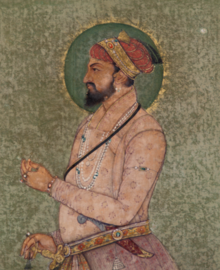| Shah Jahan III | |||||||||||||
|---|---|---|---|---|---|---|---|---|---|---|---|---|---|
| Padishah Al-Sultan Al-Azam Mirza | |||||||||||||
 Portrait of Muhi-ul-Millat before his deposition, c. 1759 | |||||||||||||
| 16th Mughal Emperor | |||||||||||||
| Reign | 10 December 1759 – 10 October 1760 | ||||||||||||
| Predecessor | Alamgir II | ||||||||||||
| Successor | Shah Alam II | ||||||||||||
| Vizier | Imad-ul-Mulk | ||||||||||||
| Born | Mirza Muhi-ul-Millat 1711 Mughal Empire | ||||||||||||
| Died | 1772 (aged 60–61) Mughal Empire | ||||||||||||
| Issue |
| ||||||||||||
| |||||||||||||
| House | House of Babur | ||||||||||||
| Dynasty | Timurid dynasty | ||||||||||||
| Father | Muhi us-Sunnat | ||||||||||||
| Religion | Sunni Islam (Hanafi) | ||||||||||||
| Mughal emperors | ||||||||||||||||||||||||||||||||||||||||||||||
|---|---|---|---|---|---|---|---|---|---|---|---|---|---|---|---|---|---|---|---|---|---|---|---|---|---|---|---|---|---|---|---|---|---|---|---|---|---|---|---|---|---|---|---|---|---|---|
|
||||||||||||||||||||||||||||||||||||||||||||||
Shah Jahan III (Persian pronunciation: [ʃɑːh d͡ʒa.ˈhɑːn]; 1711–1772), also known as Mirza Muhi-ul-Millat, was the sixteenth Mughal emperor, albeit briefly. He was the son of Muhi us-Sunnat, the eldest son of Muhammad Kam Bakhsh who was the youngest son of Aurangzeb. He was placed on the Mughal throne in December 1759 as a result of the intricacies in Delhi with the help of Imad-ul-Mulk. He was later deposed by Mughal chiefs, acting in the name of the exiled Mughal Emperor Shah Alam II.[1]
References
[edit]
Well, that’s interesting to know that Psilotum nudum are known as whisk ferns. Psilotum nudum is the commoner species of the two. While the P. flaccidum is a rare species and is found in the tropical islands. Both the species are usually epiphytic in habit and grow upon tree ferns. These species may also be terrestrial and grow in humus or in the crevices of the rocks.
View the detailed Guide of Psilotum nudum: Detailed Study Of Psilotum Nudum (Whisk Fern), Classification, Anatomy, Reproduction